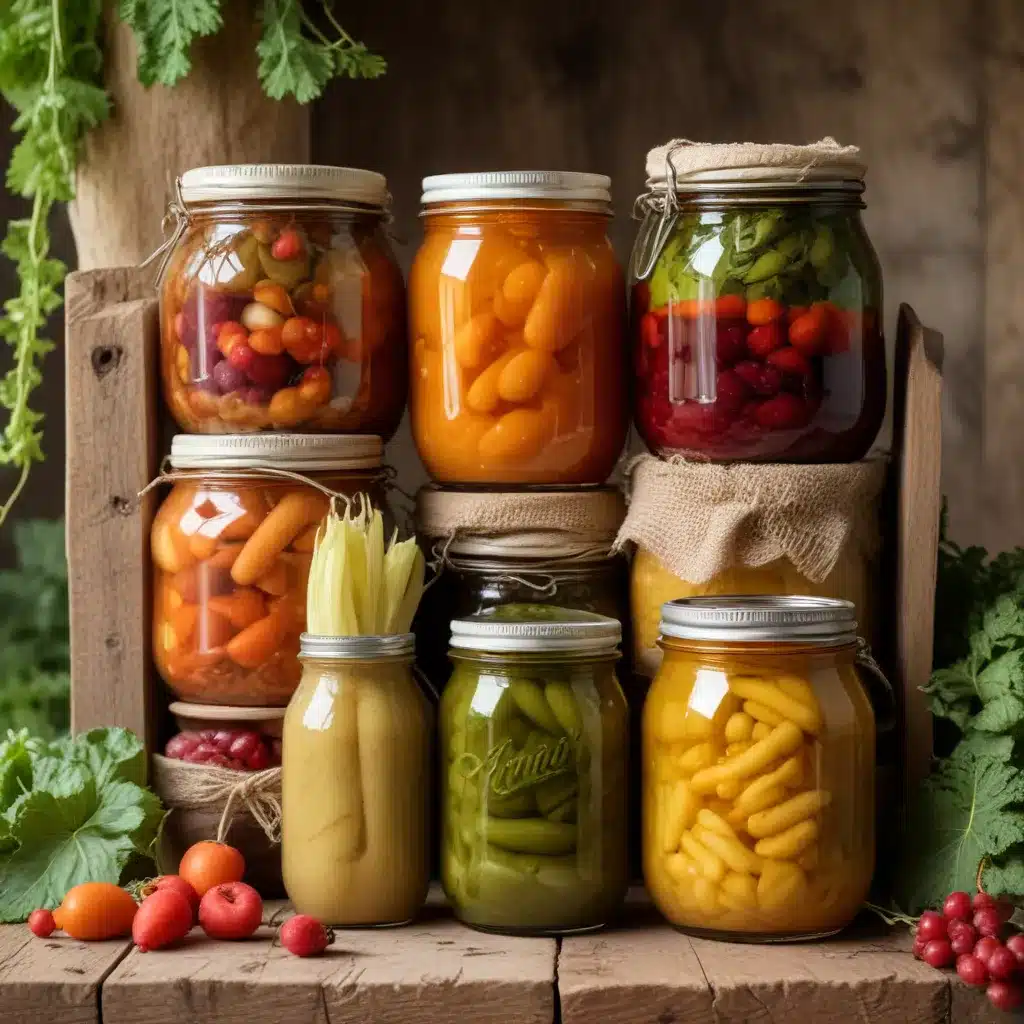
Savoring the Seasons: Preserving the Harvest through Fermentation
As the summer harvest reaches its peak at Crooked Pines Farm, it’s time to turn our attention to preserving the bounty for the seasons ahead. While canning, freezing, and drying are all excellent methods, one of our favorite ways to savor the flavors of the garden is through the magic of fermentation.
Seasonal Produce Preservation
Fermentation may seem intimidating at first, but it’s actually a centuries-old technique that’s making a big comeback as more people discover the delicious and nutritious benefits of lacto-fermented foods. Unlike canning, which relies on high heat to kill off microbes, fermentation harnesses the power of beneficial bacteria to transform raw fruits and vegetables into flavorful, shelf-stable delicacies.
Traditional Lacto-Fermentation
At the heart of lacto-fermentation is the growth of lactic acid bacteria. These hardy microbes thrive in an anaerobic (oxygen-free) environment, converting the natural sugars in produce into lactic acid. This not only preserves the food, but also enhances its nutritional profile by increasing the bioavailability of vitamins, minerals, and antioxidants.
Some of our favorite lacto-fermented staples include classic sauerkraut, zesty kimchi, and crunchy pickles. The process is simple: shred or slice your vegetables, mix in some salt and spices, and pack them into a sealed jar or crock. As the fermentation progresses, the lactic acid bacteria go to work, creating a brine that keeps the veggies submerged and protected from spoilage.
Vegetable Pickling
While sauerkraut and kimchi rely on the natural sugars in the vegetables to fuel fermentation, you can also create pickled products using an acidic medium like vinegar. This quick pickling method is great for preserving vegetables like carrots, green beans, and pearl onions, and the results can be just as flavorful as their lacto-fermented counterparts.
Kombucha Brewing
For a fermented beverage that’s full of beneficial probiotics, look no further than kombucha. This fizzy, slightly tart tea is brewed by fermenting sweetened black or green tea with a SCOBY (symbiotic culture of bacteria and yeast). The resulting liquid is packed with gut-friendly microbes and natural carbonation, making it a refreshing and healthful alternative to sugary sodas.
The Science of Fermentation
At its core, fermentation is a metabolic process driven by microscopic organisms. When produce is submerged in a brine or acidic solution, anaerobic bacteria and yeasts begin to break down the carbohydrates, producing lactic acid, alcohol, and a variety of beneficial byproducts.
Microbial Interactions
The specific microbial community that develops during fermentation is heavily influenced by factors like temperature, salt concentration, and the presence of competing microbes. In a well-balanced ferment, the lactic acid bacteria will outcompete any harmful pathogens, creating a stable, shelf-stable product.
Anaerobic Metabolic Pathways
Unlike aerobic respiration, which uses oxygen to convert glucose into carbon dioxide and water, the anaerobic metabolism of lactic acid bacteria generates lactic acid as the primary end product. This not only preserves the food, but also imparts the signature tangy, sour flavors we associate with fermented foods.
pH and Acidity Regulation
As the lactic acid accumulates during fermentation, the pH of the brine gradually drops, creating an inhospitable environment for spoilage microbes. The ideal pH range for most fermented vegetables is between 3.8 and 4.2, which helps ensure a safe, stable product.
Nutritional Benefits of Fermented Foods
In addition to the tantalizing flavors, fermented foods offer a wealth of nutritional benefits. The process of fermentation not only preserves the vitamins and minerals present in the original produce, but also increases their bioavailability.
Probiotic Microbiome Support
Fermented foods are rich in probiotics – live, beneficial bacteria and yeasts that can help support a healthy gut microbiome. These microbes work to crowd out harmful pathogens, improve digestion, and even boost our immune function.
Nutrient Bioavailability
The enzymatic activity of fermentation can break down complex molecules like proteins and starches, making the essential nutrients more readily available for our bodies to absorb. Fermented foods are also a good source of B-vitamins, which are produced by the microbial cultures.
Antioxidant Compounds
Many fermented vegetables, like sauerkraut and kimchi, contain high levels of antioxidants that can help neutralize free radicals and reduce inflammation in the body. The fermentation process may even enhance the antioxidant properties of the original produce.
Fermentation Equipment and Supplies
While you can certainly get started with basic kitchen supplies, there are a few specialized tools and ingredients that can make the fermentation process easier and more foolproof.
Fermentation Vessels
Look for wide-mouth mason jars, crocks, or specialized fermentation lids that create an anaerobic environment and allow gas to escape. Avoid using metal lids, as the acid can react with the metal.
Airlock Systems
Airlocks are designed to let carbon dioxide out while keeping oxygen and other contaminants from getting in. They’re an essential tool for ensuring a successful, worry-free ferment.
Specialty Ingredients
In addition to your produce, you’ll need non-iodized salt (which can inhibit fermentation) and any desired spices or herbs. Some fermenters also use starter cultures to kickstart the process.
Whether you’re preserving the summer’s harvest or getting a head start on winter, fermentation is a wonderfully versatile and nutritious way to extend the life of your seasonal bounty. With a little practice and the right equipment, you can turn your garden’s surplus into a delicious and gut-healthy pantry staple. Visit Crooked Pines Farm to learn more about our fermentation workshops and get inspired to start your own flavorful fermentation journey.


